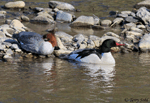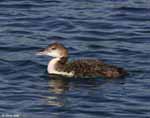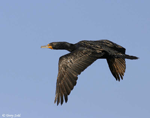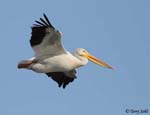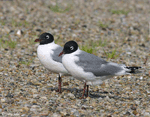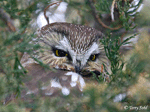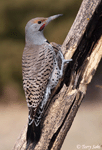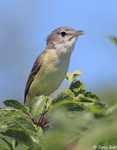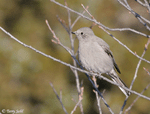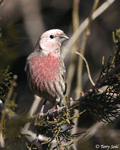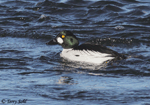South Dakota Birding Hotspot
Pierre and Oahe Dam
Stanley and Hughes Counties
| Click on points to view actual ground photos and birding information for those locations. Use the Google tools to switch between road maps, terrain, or satellite images. |
Directions:
Pierre lies along the Missouri River, with Oahe Dam only 5 miles north of the city. Many good birding locations are found in the area. Locations of some of my favorite locations are shown and discussed in sections below.
One thing to note about the Pierre area...while it is one of my favorite locations to bird, the distance from my part of the state means I only visit a handful of times a year. There's a truly wonderful birding crowd in Pierre that is typically more than willing to help a visitor to the area.
Geographic Coordinates: 44° 22' 1" N, 100° 20' 46" W (Capital Building in center of Pierre).
44° 27' 5" N, 100° 24' 10" W (Center of Oahe Dam).
Points of Note (Click on numbers on the map to see images of the locations):
One of the biggest attractions for birds in the Pierre area is the Missouri River, which flows through the city itself. A prime area to check at all seasons is directly below Oahe Dam, about 5 miles north of Pierre (Point 1 on the map). The area below Oahe Dam is perhaps the best location in the state to look for gulls and terns, especially rarities (even some normally pelagic species!) that have otherwise rarely been seen in the state. While it is a good location to check out at any time of year, the open water found below the dam even in the dead of the coldest winter makes it a tremendous attraction for not only gulls, but also waterfowl (again, with the possibility of some true rarities for the state). Wintering waterfowl and other birds also attracts Bald Eagles, which can nearly always be found in the trees overlooking the river below the dam. The forested area on the west side of the river, right below the dam, can also be a good place to look for forest species, and again, with some true rarities sometimes being found (such as regularly found Chuck-Will's Widow).
The river below Oahe Dam flows through Pierre and Fort Pierre, and near next to some more terrific birding stops. My 2nd favorite location in the Pierre Area is Farm Island Recreation Area (Point 2). The Rec. Area is found a few miles east of Pierre, along the Missouri River. It can be reached by taking highway 34 east out of Pierre, and turning right (south) a few miles east of town. Farm Island is indeed a very large island/peninsula jutting out into the Missouri River. Upon entering the park, the north side of the river contains the developed portion of the park, with a number of camping sites and picnic areas. The great group of Pierre birders often maintain feeder complexes in this portion of the park, and these areas are terrific bird magnets in the winter time. A thin strip of land connects the north shore to the island itself. At the end of the road as you head to the island itself is a parking area, and the start of walking trails. These trails are a must-stop location during a birding trip to the area, at any time of year. Several miles of trails on the island go through open areas, wetlands, mixed forest, and large areas of cedar trees. It's a great location to look for migrating woodland birds in spring and fall, and the cover offered by the cedar trees can hold some great surprises in winter.
A similar area to Farm Island is LaFramboise Island Nature Area, found right along the southern edge of Pierre itself (Point 3). A thin causeway offers access to the Island from the southwestern part of Pierre, with plentiful parking found at multiple locations. As with the river right below Oahe Dam (just several miles upstream), this is a good area to look for gulls and waterfowl, especially in winter when open water can be found even in the coldest of winters. A strong current of water flows from the main river channel on the west side of the causeway to the river area on the east side of the causeway. In winter, when most of the river to the east of the causeway is frozen, this current typically leaves a small open area of water on the east side of the causeway, an area where there are often wintering waterfowl and gulls. A large sandbar in the middle of the river, visible to the west of the causeway in the main river channel, also is a good spot to scan for rare gulls and waterfowl, although a good set of binoculars or a scope is required. At the end of the paved drive into the park is a parking lot, with the start of hiking trails. As with the Farm Island area, these trails offer a mix of open and forested habitats, and can also be very good for finding woodland species.
One other type of area I always check if I make the trek to the Pierre area are the rugged hills and bluffs on both sides of Oahe Reservoir above the dam. These rugged areas are typically covered by grassland, with cedar trees in the draws, and other little pockets of shrubby or forested habitat. One of these very near the dam is very popular for birders, and is called "Billy Goat Jump" (Point 4). This area can be reached by taking Highway 1806, which runs along the western side of the reservoir. From the western edge of the dam, take highway 1806 about a mile or a mile and half, until you've just reached the crest in the topography. Right at the crest, where the road starts to head down towards the water diversion dam/area of the reservoir, you'll see a small gravel road heading off to the right. That leads into the Billy Goat Jump area. As you first enter the road, you'll be driving past grassland along the peak of the hill. The road will soon take a turn to the right, and start to wind down towards the reservoir itself. As you go down the hill towards the small loop/parking area at the bottom of the road, you'll be passing brushy areas, and eventually, an area with thick cedar trees and scattered pines. The brushy areas on the way down can be "birdy" at any time of year, but especially so if the Pierre birding crowd is maintaining feeders in the area (which they often do). It's the cedar trees and pines towards the bottom that tend to attract most of the attention for a birder, however. Thick crops of berries on the cedar trees are a great draw for wintering birds, making this a great spot to check for winter rarities such as Bohemian Waxwings and (nearly always) Townsend's Solitaires. The cover of the trees also makes it a favorite location to look for wintering owls. Note that the road stops short of the reservoir itself, leaving a hike down if you truly want to get to the reservoir's shoreline. These brushy and cedar-filled draws can be found all along the shores of Oahe Reservoir, and any of these areas can be great spots to bird.
Birds of Note:
I love owls, and the the Pierre Area (and Fort Pierre National Grasslands to the south) offer some great opportunities for a wide variety of owls. The cedar trees at Billy Goat Jump, and at LaFramboise Island Nature Area and Farm Island Recreation Area are a great spot to look for wintering Northern Sawwhet Owls and Long-eared Owls. Be advised though...it is one HECK of a lot of work to look through the cedars in search of these guys! It's a matter of searching through the cedars for "whitewash" of a long-standing roost. I've found plenty of former roosts, but with just a few exceptions, they've been unoccupied when I've found them. My best luck finding these guys in the Pierre Area? Relying on the wonderful Pierre birder group for active roosts that they have found. Another owl species that must be mentioned are Barn Owls. In recent years, Pierre area birders have found that the species commonly nests in burrows in the soft banks on the bluffs on the shores of Oahe Reservoir and the Missouri River.
The big attraction for a birder in the immediately Pierre area though is often the chance for a rarity along the Missouri River. Practically any species of gull that has been found in the Upper Great Plains may be occasionally found below Oahe Dam. Rarities spotted in the area include Mew Gull, Sabine's Gull, Lesser Black-backed Gull, Glaucous Gull, Iceland gull, and Black-legged Kittiwake. Pelagic species such as Pomarine Jaeger, Parasitic Jaeger, and Long-tailed Jaeger are extremely rare in the interior of the continent, but have all been spotted in the area. The winter of 2007/2008 brought much excitement to birders in the area, as an Ivory Gull was found hanging out near Oahe Dam. Other gulls commonly found at some point during the year are Ring-billed Gull, California Gull, Herring Gull, Bonaparte's Gull, and Franklin's Gull. The open water below the dam may hold Common Loons at any time of year (including non-breeding summer birds), while the possibility exists for other, much more rare Loon species. Rare waterfowl may also be found here, with past finds including Harlequin Duck and all three Scoter species.
The Pierre area, again, in combination with the Fort Pierre National Grasslands to the south, are my favorite birding location in winter. Given the vast number of Cedars (and often huge crops of berries) found along the Missouri River in the area, even winter sometimes seems to lose it's grip. American Robins can sometimes be found in and around the cedars, even in the dead of winter. Cedar Waxwings can be abundant, and a look through the flocks may reveal a few Bohemian Waxwings as well. Townsend's Solitaires are often found, while winter finches (Purple Finch, Pine Siskin) and occasionally Pine Grosbeak can also be found in these areas.
Forested areas at LaFramboise Island and Farm Island can be good at any time of year for seasonally appropriate forest species.
Other Birding Locations (sorted by distance):
- Fort Pierre National Grasslands (~15 miles)
- Presho Area (~45 miles)
- LaCreek National Wildlife Refuge (~150 miles)
- Lake Thompson Area (~165 miles)
- Madison Waterfowl Production Area (~200 miles)
- Dakota Nature Park, Brookings (~205 miles)
- Western Minnehaha County (~205 miles)
- Wall Lake / Dewey Gevik (~215 miles)
- Outdoor Campus in Sioux Falls (~225 miles)
- Big Sioux Recreation Area (~230 miles)
- Good Earth State Park (~235 miles)
- Beaver Creek Nature Area (~235 miles)
- Newton Hills State Park (~255 miles)
- Gavin's Point Dam (~240 miles)
- North Alabama Bend (~270 miles)
